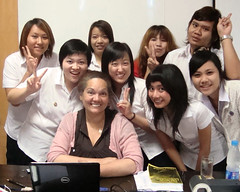
Thailand’s reverence for teachers took a little getting used to for Neag professor Xae Alicia Reyes, who spent six weeks in the southeast Asian nation as a Fulbright Senior Specialist. The experience, says Reyes, reinforced her strong belief in education as a bridge between cultures.
Reyes, an associate professor in the Department of Curriculum and Instruction and interim director of UConn’s Puerto Rican and Latin American Cultural Center, served at Burapha University in Chon Buri last summer, not far from Bangkok. Her students were Thai and Chinese.
“I took my teaching style, based on Paulo Freire’s dialogical model, to Thailand,” Reyes says, “and I validated my approach of bringing people together to explore their cultural differences.”
It was also eye-opening for Reyes to experience the deferential treatment of teachers, including the traditional “wai,” the Thai greeting made by placing the hands together and bowing. The teacher returns the greeting, but never initiates it, a sign of his or her high standing in the culture; but, adds Reyes, “it can be a bit uncomfortable at times for those of us who come from societies where equality is a core value and deference to certain individuals is not promoted.”
The university also has many religious altars throughout the campus where students place offerings and “wai” in passing, she says, “showing the integration of the spiritual with the secular.”
Another striking difference is the use of uniforms by students at all universities throughout the country.
In addition to teaching courses in multi-cultural communication for students in management, marketing, and human resources development, Reyes’s work involved mentoring her teaching assistant, who had been hired as an instructor at Burapha for the fall semester. The TA’s only job during Reyes’s six-week term, however, was to shadow her and learn how to teach. She and Reyes conducted “de-briefing” sessions after every class. The mentorship, according to Reyes, was the most memorable aspect of her visit.
“Now there’s an induction process for you,” she says. “We have teaching assistants in our universities, of course, but I have never seen a new faculty member so embedded in the process. I’ve never seen it done with such detail and care. It’s a model we should embrace, both to help new faculty and to encourage respect for those who are experienced faculty.”
Since community service is an important part of Thai student life, there were frequent field trips that allowed Reyes to see the country up close. At an orphanage and at a school for the blind, she and her students helped give out snack packages to the children while watching them create handmade crafts and use computers to produce printouts of their writings in Braille. She calls it “a powerful experience” for all involved and another aspect of Thai culture that she would like to see more American college students emulate.
“Although we have increased service learning requirements in many of our schools,” Reyes says, “this commitment to give back needs to be integrated in all learning.”
The Fulbright program in Thailand also maximized the opportunity for faculty dialogue by arranging for Reyes to visit Mae Fah Luang University in Chiang Rai, where she presented on her work at Burapha to the Deans Council.
Reyes’s enthusiasm for both Thailand and the Fulbright program remains strong, and she is hopeful of another posting in the future, though she would consider a return to Burapha with or without a Fulbright.
She had been told, she says, that the Thai people are sometimes called “the Latinos of Asia; they are so outgoing and expressive. I found them a wonderfully warm people with a joy for living that reminded me very much of life in the Caribbean.”
 Facebook
Facebook
 Twitter
Twitter
 LinkedIn
LinkedIn
